NASCAR's stars may be shining, but over on the low-budget side of the stock car racing garage storm clouds are brewing

Whoops! This sport is expensive...even for NASCAR's highest paid driver, Dale Earnhardt Jr. ($28.2 million earned last season, ranking him 23rd among all the world's athletes, according to Forbes)
By Mike Mulhern
mikemulhern.net
BROOKLYN, Mich.
Cutting costs in racing?
Fine and noble. But as Eddie Wood likes to say 'When that toothpaste is out of the tube, it's hard to get it back in.'
And with 14 different winning drivers in the season's first 22 Sprint Cup events, and number 15 maybe coming here Sunday, it could easily be argued that things are going just fine in this sport...particularly given the still very tough economic times here in the NASCAR garage.
However....
While so much media focus is being put on the sport's rich-famous-and-powerful teams, and the battle for a wild card spot in the championship playoffs, and the in-fighting between top drivers, over at the other end of the garage - where the low-budget and no-budget teams are trying just to survive -- the story lines are quite different.
And you won't see it on television or on the pages of what passes for sports journalism these days.
Maybe it's just not as TV-sexy for the networks to talk with the Scott Riggs and David Ragans and David Stremmes of this world. TV would rather focus Jimmie Johnson's bid for a sixth championship, or Kyle Busch's fight to make the playoffs.
But you don't have to walk far down the line of big-rig haulers -- lined up by points, and thus sponsorships too -- to find the demarcation line between the Haves and Have-Nots.
"It's right there, at the 42 hauler," one top crew chief says, pointing to the Juan Pablo Montoya-Chip Ganassi-Target-sponsored camp -- 22nd in the current Sprint Cup standings. Everyone from 23rd on down, he says, is pretty much just struggling to survive.
Remember, this is sponsorship search part of the season too. Team bank accounts for 2013 are being filled right now, and if you don't sign something good over these next few weeks, well, the future isn't looking bright.
No wonder such a gloom inside too many haulers, among car owners and crewmen alike, wondering what the future really holds for them.

Dave Rogers, as crew chief for Kyle Busch, is under heavy pressure to get his star in the playoffs (Photo: Getty Images for NASCAR)
So Dodge is pulling out of NASCAR...and the ramifications are starting to be felt.
What if another car maker were to follow suit? Now how many more racers would that put out of work too?
No one seriously expects that to happen. But then no one really thought Chrysler would call it quits either, after investing so much in this sport.
Whatever the illogical thinking behind the Chrysler-Fiat decision to pull the plug on stock car racing -- Hey, Dodge is a high-performance brand, for goodness sakes!? -- certainly now other car makers could have pause to stop and consider just what they're getting for their money in this sport.
If Chrysler execs don't think NASCAR gives them enough bang for the buck, well, that thinking could be dangerously contagious.
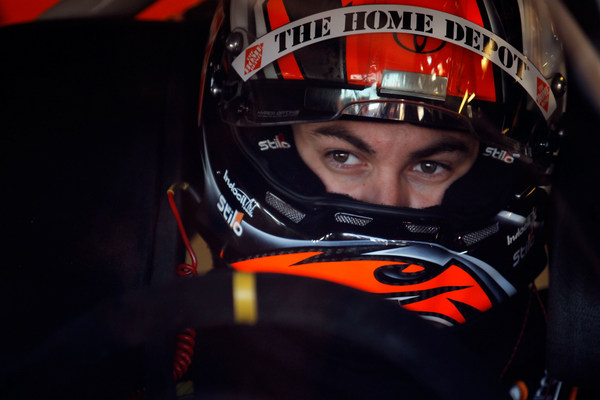
Joey Logano: still just 22, but a tour veteran. How much is he worth? How much is he asking Roger Penske in salary for that Shell-sponsored ride? (Photo: Getty Images for NASCAR)
The August Michigan 400, on Woodward Dream Cruise weekend, is typically a weekend where Detroit car makers are centerstage.
And someone just parked a beautifully restored 1938 Hudson Terraplane at the door to the NASCAR garage. Jack Roush perhaps?
Ford had a big to-do over in Dearborn, with all its NASCAR teams on hand. Chevrolet had a big NASCAR to-do over there too.
...which of course makes it all the more fun for Toyota when it can upstage its racing rivals here, as Mark Martin did Friday and as Kyle Busch or Denny Hamlin or Martin Truex Jr. could in Sunday's 400.
Michigan International Speedway is right in Detroit's backyard, and just about everyone who's anyone in the business will be here Sunday at the track.
Yes, they might be reminded that the Michigan economy is still ragged, as they drive down US 12 past too many boarded-up entertainment haunts in the scenic Irish Hills, like Kelly's on the Hill. And the corn fields, with this drought, are looking parched too.
And if they can get past the high-dollar teams and wander over to the fourth-turn suburbs, they may be reminded too that the NASCAR economy isn't doing all that well either.
Plus, there is at the moment a big question about why NASCAR executives were unable to persuade Dodge either to stay in this sport or to engineer a more graceful exit. After all one of the main duties for CEO Brian France is to babysit the sport's key corporate players.
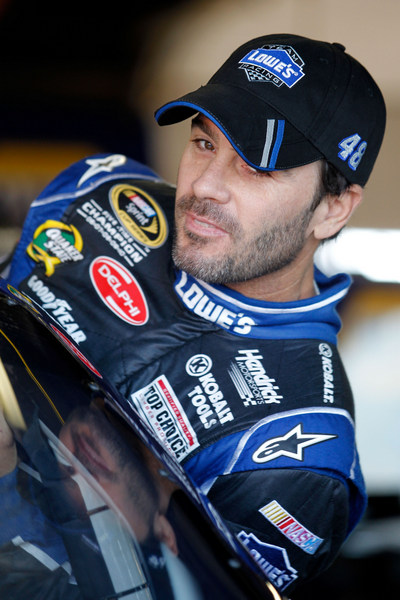
Jimmie Johnson: on a roll. Peaking too soon? Or is Number Six in the cards? (Photo: Getty Images for NASCAR)
Down here in the low-budget suburbs, there are grumblings that NASCAR executives may need to make some dramatic, even radical moves, to fix things.
Maybe even some new ways of thinking about this sport.
"You just don't see the passion for this sport anymore," one former team owner says of the current power structure running things.
"When Bill France Jr. was around, he was around every weekend, working the garage, talking to teams, talking to drivers.
"Bill Jr. had a real feel for this sport...a real passion....a real fire.
"And if he saw something he didn't like, by golly, he'd change it.
"Now I might not have agreed with everything Bill Jr. did, but he was always here, and you knew he cared.
"Today....."
And his voice trailed off.
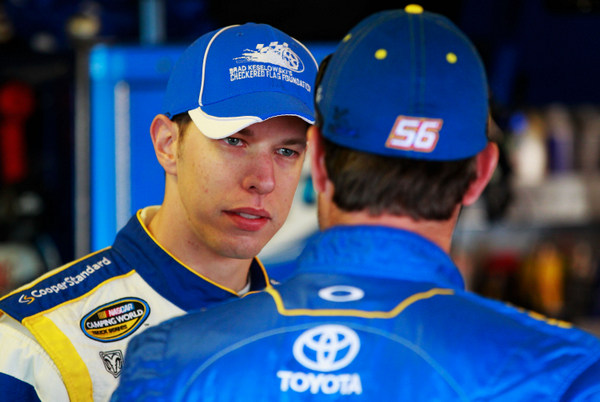
Brad Keselowski, talking with Martin Truex Jr. Both set for the playoffs (Photo:Getty Images for NASCAR)
Among the rumblings:
-- First, maybe limit owners to just two Sprint Cup teams. Force mega-team owners to break up.
But would that really solve any problems?
A race team is essentially worthless without a big sponsor. Teams that win gets those big sponsors, and those that don't, don't....reinforcing the major issue here, that it's hard to get big buck sponsors to come into the sport.
Fortunately Rick Hendrick was able to wrangle another sponsorship package for Dale Earnhardt Jr. with the National Guard, even in the face of some Congressional opposition. A big plus for the sport there.
Breaking up the mega-teams? Looks like the still sluggish economy is doing that job. Hendrick is the only man still with four teams. Loss of sponsorships have forced rivals to cut back to three or two.
Tom DeLoach, owner of the Red Horse Racing Truck team, just reopened one of his teams, after being forced to shut down earlier this year for lack of sponsorship.
On the Cup side, James Finch is feeling the economic pinch too, with another week at the track with no sponsor on the quarterpanel, and another wrecked car already on the hauler.
There is speculation a top Nationwide team too is feeling the economic winds in its face....
Even some of the biggest names in the sport are struggling:
Ford was unable to keep Matt Kenseth in the fold, after 14 years, seemingly because of sponsorship issues, and the two-time champion is apparently moving to Joe Gibbs' camp with Home Depot sponsorship. UPS and Crown Royal have dropped out, and Aflac. Trevor Bayne, last year's Daytona 500 winner, is still searching.
In fact the feeling in some parts of the garage -- and this sounds almost shocking -- is that the sport is turning into pretty much a three-team sport, dominated by Rick Hendrick, Gibbs and Roger Penske. It's a bit unclear what to make of the rest.

Trevor Bayne: a footnote to history, or a budding star? (Photo: Getty Images for NASCAR)
-- Second, open up the 'box' that teams are allowed to work in -- essentially give crew chiefs more leeway to be creative.
When NASCAR, with the car-of-tomorrow project, in 2007-2008, decided to significantly 'tighten the box' of rules in which teams are allowed to work, the aim was noble: level the playing field, give the little guys a better chance to compete against the sport's big guys.
Admirable.
However what actually happened is that the price tag for 'innovations' sky-rocketed. More engineers were put on the job, more tricks were devised at higher cost. And the little guys were again handicapped.
Here's one classic example: remember the trick 'cambered rear ends' that Harry Gant used to win four in a row back in the fall of 1991?
A better light bulb.
Today NASCAR would never allow a crew chief to use anything novel like that; in fact it would probably penalize him.
Over here on the back side of the Cup garage, some crews are saying they'd like a little more wiggle room in order to try to compete against the high-dollar teams.
Whether or not that would work isn't clear. Even with the 'box,' wily Chad Knaus still finds ways to make things work better for Jimmie Johnson.

Clint Bowyer. Did we say his sponsor is......(Photo: Getty Images for NASCAR)
-- Third, do something about the sport's engine programs. There are five major engine programs now, run by Hendrick, Jack Roush, Richard Childress, Toyota/Joe Gibbs, and Penske. Next season that will be only four, with Penske and Roush teaming.
The days of independent engine builders and small teams doing stuff in-house are history. To be competitive today, you have to lease an engine from one of the four powers, at anywhere from $65,000 to $100,000 a race. That's close to $4 million a season. And if you want more horsepower, just pay more.
"Engines and engineering, those are the two budget killers," one independent car owner complains.
Engineering like carbon-fiber-this and carbon-fiber-that, and who knows what all computer-engineered tricks.
One former team owner who has done a spread-sheet on the actual cost of a competitive Sprint Cup engine says the engine-leasing programs are big money makers for those who run them: a fresh engine may cost $60,000 to $80,000 to build, and lease for $100,000 a week. Then, he says, that engine goes back to the leasing engine department for 'refreshing,' which costs maybe $20,000 -- and that engine is turned around and leased again the following week for $100,000.
"There is a huge profit margin in those engine programs," he says.
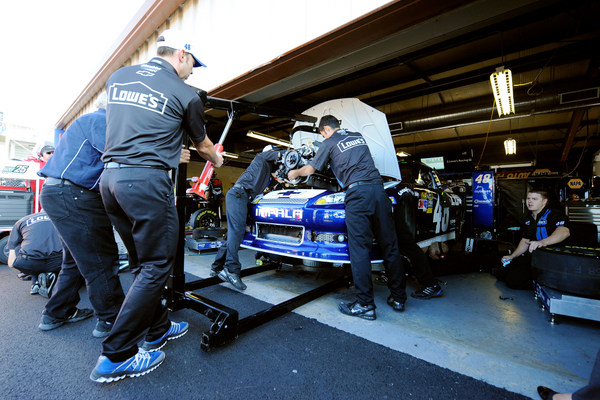
Jimmie Johnson's crew making an unanticipated Saturday morning engine change (Photo: Getty Images for NASCAR)
-- Fourth, maybe limit the number of crewmen who can actually sign in each weekend at the race track. Travel budgets are killing some small teams, while big teams can fly in specialized pit crews for the race.
Bill France Jr. himself once suggested just this. Maybe it's time to rethink that idea.
"When I was racing," a former car owner said, "I only had half as much sponsorship as the big teams I was racing against.
"I told Bill Jr. that, while you can't keep a man from getting a bunch of money to run this stuff, you can find ways to keep him from spending too much of that money on the car and the engine. Make him spend all that extra money on bigger, faster airplanes or fancier motorcoaches....but not the race car."
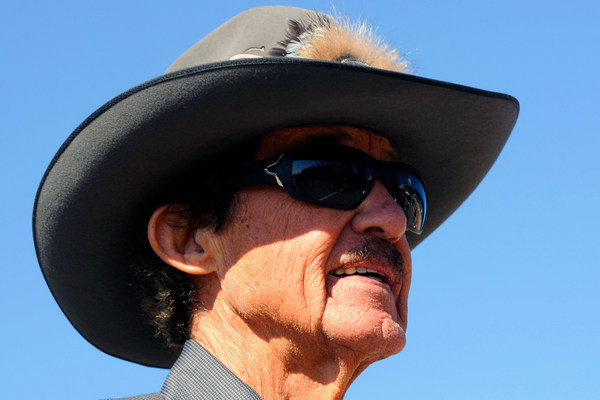
Richard Petty: under pressure to get a new contract signed....by someone (Photo: Getty Images for NASCAR)
Some NASCAR rules have done just that. The one-engine rule has been amazingly successful, for example.
However the car-of-tomorrow has been pretty much a mess from the start. "We told NASCAR not to do the car-of-tomorrow, that we could fix whatever they wanted safety-wise in the cars we already had," one team owner says angrily. "They didn't listen. And they came up with this car that is so poorly designed that you have to put all sort of (lightweight) carbon fiber stuff on it, so you can just get it to drive around the corner."
And when it comes to such lightweight design items, the mega-teams of course gain another advantage.
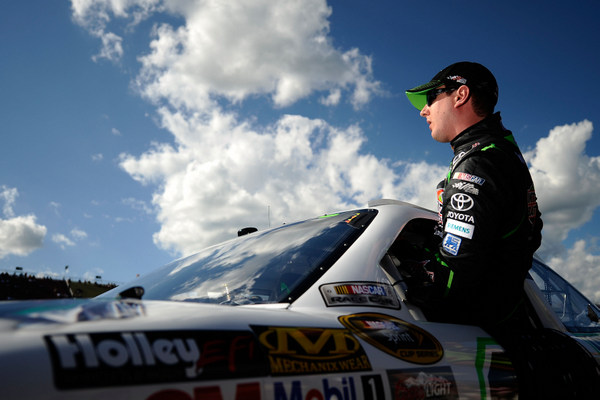
Kyle Busch: still miffed over losing at Watkins Glen (Photo: Getty Images for NASCAR)
When Richard Childress started out in the sport, as an owner-driver, up from the Bowman Gray Stadium world, he had a two-man team: he himself and teenage crew chief Tim Brewer, working out of a one-bay garage in southside Winston-Salem, N.C.
That was 1971. Childress was 25. This sport was much, much different.
There were only a couple of 'super' teams back then, the Pettys, the Woods, Bud Moore, Junior Johnson. The rest of the field was filled with independent owner-drivers.
Man, how things have changed.
Has it really been 15 years since Ricky Rudd, one of the last of the die-hard owner-driver independents, pulled that big upset at Indianapolis by winning the Brickyard 400?
Since then, if you're not driving for one of the sport's mega-teams, or saddled up with one of them as a 'satellite' or R&D operation, you just can't play the game.
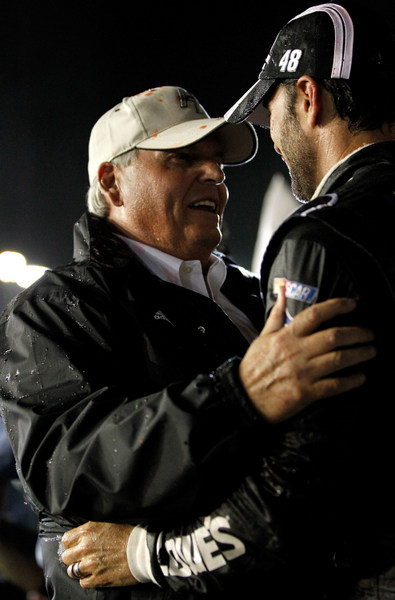
If only everyone in the sport were as successful as Rick Hendrick....(Photo: Getty Images for NASCAR)
In the wake of Chrysler-Fiat's decision to take its Dodge division off the playing fields of NASCAR at the end of this season, after 12 years on the major league stock car tour, perhaps it's time to look at a few aspects of this sport and maybe reconsider some things.
Maybe the business model of owner-driver simply doesn't work any more.
Maybe that business model, though it was the heart of the sport for decades, has been wiped out by the rise of the mega-teams.
Maybe having a few mega-teams is good for this sport. Maybe not.
Even men with power and money and equipment -- like Chip Ganassi and Felix Sabates -- struggle to be competitive. (Ganassi has 10 wins in his 12 years in the sport, and his last tour win was over two years ago.)
Still a big question is how does this sport attract new team owners?
So maybe having some viable owner-drivers around might be good for the sport.
However two men who certainly have the savvy and talent to fill that role -- Kevin Harvick and Robby Gordon -- have taken themselves out of that picture. Harvick, after building Kevin Harvick Inc. into a powerful, on-the-rise Nationwide operation, last fall shut the doors and turned off the lights. And this spring Gordon too all but shut down his NASCAR Sprint Cup operation.
What is wrong with this sport that men like Harvick and Gordon cannot make a go of it?
What needs to be fixed?
Can anything really be fixed?

Why has NASCAR priced so many independent owner-drivers out of the sport? How to fix the problem? Or maybe it doesn't need fixing.... (Photo: Getty Images for NASCAR)
But then who in their right mind would try to jump in here and compete against teams staffed with more than 500 highly talented people and all kinds of expensive equipment
Would you really want to sit down at this poker table?
Robby Gordon is quick to raise his hand. Give him another shot, he says. (And the cold shoulder Dodge execs have given Gordon was surprising, and, to be honest, rather unprofessional.)
Part of Gordon's argument: "Look at the top teams -- where is the 'youth' market, where is the 'youth' owner?"
Indeed, the top team owners are aging: Hendrick, 63; Roush, 70; Penske, 75; Gibbs, 71; Richard Childress, 66.
Does this sport need a more balanced demographic among owners? Gordon, at 42, would say yes.
But maybe NASCAR is satisfied with the status quo, with the monopolies that rule today. Maybe that's the business model NASCAR wants.
Hendrick and Childress run the Chevrolet monopoly. Roush runs the Ford monopoly. Gibbs essentially runs the Toyota monopoly.
Gordon: "Roush builds all the Ford cars. There is no Ford team besides Roush -- and this includes Petty -- that builds its own race cars.
"Richard Childress takes care of Furniture Row (the Barney Visser-Reagan Smith team); all the cars at Furniture Row come from RCR. Furniture Row doesn't build engines, and it doesn't build cars.
"Richard Petty doesn't build engines, doesn't build cars.
"And Petty really doesn't have a 'racer' running that race team.
"This is where I fit in -- I'm still a racer. And we -- Robby Gordon Motorsports -- still manufacture.
"We have an engine shop, with Joey Arrington, and we have the tools to compete...if we had the right funding. This is Ray Evernham's old shop...where they actually developed the Dodge engine. It's got 60,000 square feet, right down the road from Charlotte Motor Speedway, and it's got the tools to do the job.
"We are a viable option....but today we just don't have the funding to compete.
"Give us funding for three months, and we'll be running in the top-20 every weekend."
Maybe Robby Gordon should be here Sunday making that pitch to the guys from Detroit.
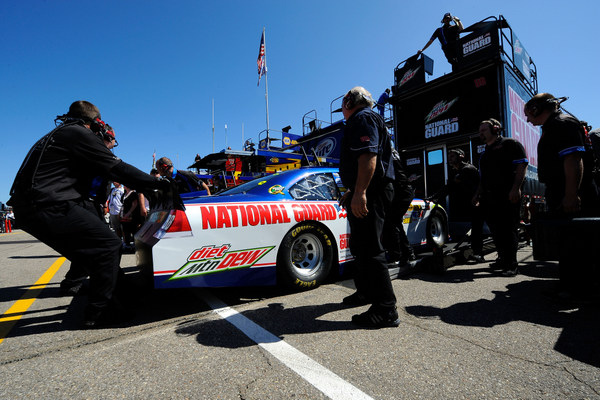
Dale Earnhardt Jr.'s crew rolls a backup off the hauler (Photo: Getty Images for NASCAR)
© 2010-2011 www.mikemulhern.net All rights reserved.
Web site by www.webdesigncarolinas.com







Cost Cutting Idea
My idea for NASCAR cost cutting based on the premise that the COT can race at Martinsville one weekend and Talladega the next weekend using the same car:
Because NASCAR keeps track of chassis using bar codes, each team is allowed only 12 chassis a season. That means 12 for the #48, 12 for the 24, etc. and they ARE NOT interchangeable. This would cut the cost of chassis development and having to build several generations of chassis throughout the year. If a team ruins a chassis or wants to build a new one, there is a 10 point penalty. During the offseason, only 6 chassis can be replaced.
Lighten the cars. I never knew the issues with the COT until reading your article, therefor I didn't know special light-weight parts were having to be developed. I know NASCAR is making the cars 100 lbs lighter next season but why not make them 500 lbs lighter? That would make the cars handle better without using light weight parts.
Make some kind of engine rule where the same engine has to be used in consecutive races.
Change qualifying. Teams practice the first day. Cars qualify by running ten consecutive laps (more or less depending on the track) or even heat races. The teams are divided in three groups based on the speeds of the first practice. Basically road racing qualifying rules. This would be more entertaining for TV and teams wouldn't have to waste a practice with just qualifying. Both practices would benefit from race setups.
Trim the fat. Cut some 1.5 mile tracks.
NFL can limit team rosters, why can't NASCAR? Each team only allowed certain number of crew chiefs, engineers, various specialists. Unfortunately this would cost some folks their jobs but, if HMS is only allowed 10 cup holder engineers instead of 20, there are 10 top engineers that can be hired by TBR, RPM, Furniture Row, etc.
All cost cutting measures mean ALL team need less sponsorship dollars which helps EVERYONE.
Cost Cutting Ideas
Realistically the one way to attack costs is to stop letting the factories and the teams introduce new parts and to start limiting team rosters (this includes reduction to two-car teams) and team spending. It's gotten beyond the point where attacking wind tunnel time, limiting what chassis are used at what tracks, and the computer engineering invested into the cars can be any kind of viable idea, and if anything opening testing back to what it was before 1990 can only help smaller teams. Monitoring team spending can be done.
"Cut some 1.5 mile tracks." Why? They're better than places like Bristol and the road courses.
Lightening the cars sounds like a good idea until one remembers they were 3,700 pounds in the halcyon days of the 1970s and 1980s - they've shed some 300 or more pounds and it hasn't made the racing better. Maybe adding weight should be tried instead.
I'm sick of these ideas for qualifying. Just hold a random draw for starting spots if anything.
David VS Goliath
Great column...except...all your photos were of "the A teams"! If you're truly concerned where the sport is going..and want to see the smaller teams make it in NASCAR...you goofed! You did exactly what you say is wrong in NASCAR... Turned your back on the teams parked on the backlots and gave us recycled pictures of the Top Guns!
This is what happens when you have a bottom line
This is what happens when you have a bottom line 'marketing' man in charge. Nascar sucks up sponsors to be "The Official Nascar....whatever", which takes away the possibility they would sponsor a race team. BZF is not a racer at heart, and has no interest in anything but enhancing Nascar's bottom line. This is what happens to a sport when you put the village idiot in charge.
We will get a Ricky Stenhouse, a qualified
We will get a Ricky Stenhouse, a qualified candidate for Rookie of the Year, but, what is not as quality is journeymen who do not have anything, or new clubs to fall back on. I would like to see Penske take a quality journeyman or woman vs. Joey Jerk.
Cut the fat? Cut the cost? Ok, eliminate the
Cut the fat? Cut the cost? Ok, eliminate the backup cars! Bring your best car and let the chips fall where they may. Let that level the field both in competition and cost.
Cost Cutting
Very good ideas at cost cutting, wonderful in fact. How about it being two pronged attack. Make the racing exciting with real racing. THE ADVANTAGE OF THE LEAD CAR NEEDS TO BE ADDRESSED. THE ADVANTAGE SHOULD BE DESTROYED. DIRTY THE CARS UP. MAKE IT A DISADVANTAGE TO BE THE LEADER!!!! AND MAKE THEM QUALIFY THIS WAY, NO TRICK CRAP.
Reply to comment
Trouble brewing
Nascar is heading down the road that the Indy Car bunch is on. Changes should be swift and big.
If I could be the Nascar King for a month, I would change the cars by standing the windshields up, taking away the front spoiler, putting a 4 inch spoiler on the rear, no side windows, old style window nets, open the grill opening up to 30inch by 12 inch, coil over shocks and springs. Engines any size, just have to weigh 9.5 pounds per cubic inch with a 2800 min. A tire so hard it would run 200 miles or better. Go back to running 70 races per year, with half on short tracks and include 15 dirt tracks per year. Start the fastest 40 cars no matter who gets left out. Limit the crew members to only those who really work on the cars not just pit them. Make the shows all a one day event. Track opens for inspection and practice at 8 am time trail at 11 one lap only. Race at noon. If it is a night race track opens at noon race at 7 pm and we are out of there by 10 p. A few special shows with nationwide cars running two fifty lap races in between two 100 lapers for the cup cars. And a driver could only compete in one series on that day. The nationwide deal would end and go back to running the local tracks with only 6 big events per year for this type on car. That is just the changes I would make in the first week. Oh and a ticket to any event would be $15 and kids under age 16 are free.
Hot dogs a buck fifty and cold drinks are 1.oo........I think it would work.
Good Ideas, and Here's Some More
The mega-teams are killing it right now, and NASCAR is just feeding the monster with their rules, or lack thereof. Here's some things that could help, too:
-- Open up testing for every TEAM. And that means increasing the number of tests, but if you have 4 cars on your team or 1 car you get the same number of tests. You want to share info, fine, but you aren't getting 16 tests compared to 4 for a single-car team.
-- No team can make parts for another team. It's a conflict of interest, for one, but it does away with any independent manufacturers having a shot at being in the business also if all of the little teams are forced to buy their parts from the mega teams. And another thing, leasing and buying from the mega teams just keeps feeding them money as you showed in the story. That needs to be nixed. No more Hendrick North (aka Stewart-Haas) or Childress West (Furniture Row) or Roush South (RPM). Either the team or manufacturer supplies its teams their engines, chassis, and other parts, the manufacturer does, or they come from an independent 3rd party. While the mega teams would still have the advantage of having these parts, that income that helps prop them up would go away.
-- Before doing away with the 4-car team, I would try the changes above to see if that helps for a couple of seasons. If it didn't, then I would cut it back to three, and then to 2. I'm not so sure that the number of cars per team is the whole issue versus the fact that they keep getting all of the additional income from chassis and motors from the other teams, and that with testing so closed up they have the hi-tech simulators that have their cars track ready before they even arrive along with the benefit of the additional tests from having the multi-car team. It makes a big difference when you can tweak your car a little versus having to make major changes during practice to get it right. The mega teams would still have these simulators even if you opened up testing, but the little guys could learn a lot from the real thing and it would put them a lot closer to a level playing field from the testing rules that are in place right now.
Cost of NASCAR engines
NASCAR allowed toyota to build a race only engines to get them into NASCAR where the American car companies all now have 500/600HP engines in their production cars. These engine would not cost $75 K and there is no need to have engines that turn 9500 RPMs. look at the production based engines used in Grand Am sports car racing. Years ago we raced in NASCAR at Daytona 500 with engines I built in my basement